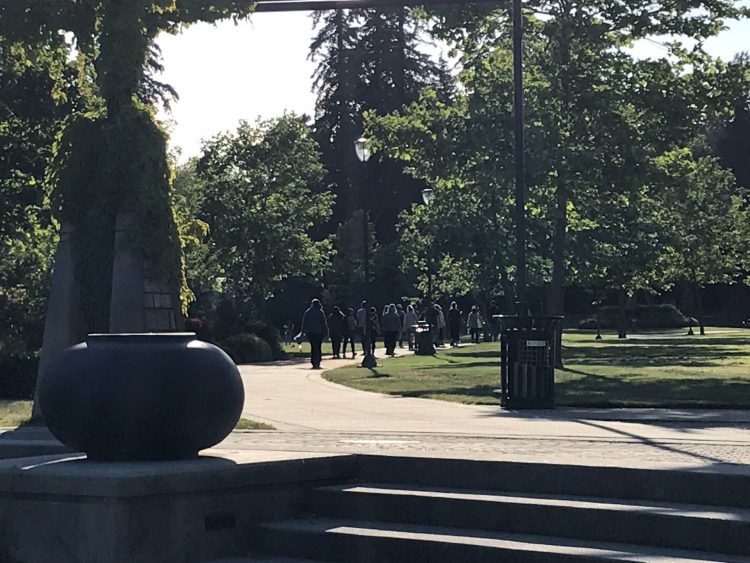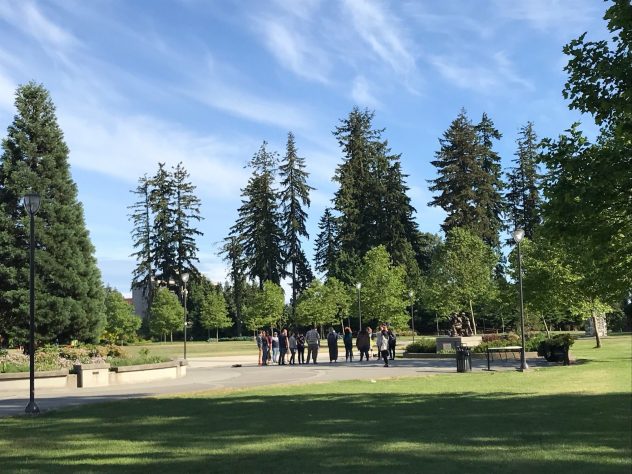Since The Walking Curriculum: Evoking Imagination & Developing Sense of Place (K-12) was published earlier this year, I’ve enjoyed learning about how educators are using the concepts with their students. The common denominator is this: Imagination- and inquiry-focused walking-based activities are radically changing the learning context for students. (If you happen to be on Twitter, search #walkingcurriculum and explore the range of activities taking place around the world.)
While the Walking Curriculum book is designed for K-12 teachers, the ideas are fruitful for Higher Education as well. This post describes ways in which members of the Creative Academic community employ walking-focused activities in their Higher Education teaching contexts. I have also written about how walking-focused and Place-Based activities can be employed for understanding notions of story/narrative with graduate students.
The following Place-based educational activity involves walking, wonder and imaginative engagement in a course on Teacher Professionalism.
What values guide the professional lives of teachers?
Tim Waddington, professor in the Faculty of Education at the University of British Columbia, recently asked his pre-service teachers to do the following outdoor, walking-based activity:
Discover five types of tree or plant around campus that appeal to you on the grounds they remind you of professional values that you have come to appreciate as important in the lives of educators. Upon your return, you will be asked to (a) describe the tree/plant in particular detail, perhaps with a photograph, drawing or verbal depiction, (b) make connections to the professional (‘heroic’) value that the tree/plant represents for you, (c) explain the importance of that value to a robust sense of professional life, and (d) discuss where you have seen (or wish you had seen) this value enacted in your experience as either a teacher or a student.
Like all Walking Curriculum practices, the activity combines the use of cognitive tools that engage students’ imaginations, with an outdoor, Place-Based focus. This is an unusual combination in the context of Higher Education. Most Higher Education learning is indoors and, more often than not, one hears little talk of engaging students’ imaginations. (Isn’t that stuff for kids?)
When you think of universities or colleges you may envision—as I do—students sitting at tables or desks, or maybe working in labs or, perhaps, sitting in large lecture halls. There are “routines” and contexts students in Higher Education come to expect. I know my own 10+ years of post-secondary rarely deviated from an indoor context. But going outside, moving and exploring in an outdoor context can have positive impacts on learning.
First, moving outside–and simply moving–breaks routine. A change of learning context involves students’ experiencing the “unusual” as opposed to the usual; this can ignite the imagination. Students are suddenly in a different physical and potentially idea-provoking space which can engage interest, attention, emotion. The unexpected nature of what may be discovered in an uncontrolled environment—and the sheer diversity of responses possible to open-ended activities—evokes emotional responses from students.
Of course, we can also “change the context” of learning indoors by practicing different teaching strategies (e.g. role play vs. direct instruction)—effective teachers do this by employing a range of teaching strategies. So why walk? Why go outside? This is where the aims of Imaginative Ecological Education (IEE)—engaging all learners with the natural world as a context for learning—come into play. If students are open to the learning—if they are affectively receptiveto Place—the natural world can be a “teacher”, the Place can provide insights for learning of all kinds.
In addition to evoking a dramatic change of context for learning, the activity is rich with cognitive tools that connect students’ emotions and imaginations with the subject matter. This is Imaginative Education (and this isn’t typical of pedagogy-talk in Higher Education).
Pssst! New to the notion of cognitive tools and Imaginative Education? Find out all about the power of these tools for learning in the Tips For imaginative Educators Series here, on imaginED.
In this particular activity students use metaphor, mental imagery, heroic qualities, and emotional significance (the story-form) in their exploration of teacher values. You may have noticed in the activity description above, for example, that students were asked to identify a professional value that is also described as “heroic”—the identification of transcendent human qualities is an example of a powerful cognitive tool.
A Few Student Reflections
Here are some of the students’ initial reflections on part (b) of their teacher/value, walking-based explorations:
GENEROSITY I noticed a solitary deciduous tree with a really large canopy stood in the sun but provided the shelter necessary to for other plans (ferns and ivy) to prosper.
HELPING OTHERS There is a tree growing from a dead rotten stump, a nurse log.
DIVERSITY I noticed a flowerbed in various stages of bloom. Everything grows at its own rate. Being able to acknowledge we all have different rates and paths.
PATIENCE There was MONDO grass. That takes a long time to grow.
INTERCONNECTEDNESS I saw a mushroom growing on a grassy knoll. The mushroom is only the bloom; better the mushroom is the underground mycelium connection of the roots.
GROWTH There is no “top” of a tree. It just keeps growing higher.
PERSISTENCE I saw a flower growing out of a TINY gap in concrete.
ACCEPTANCE We found an ugly dog that went up to everyone for loves.
RENEWAL There was a pile of dead ferns with two still flourishing on top. We also saw a fallen tree with a new tree growing out of it.
EFFICIENCY We noticed big leaves with thin hard stems that capture water and channel it down towards the roots.
MODESTY I saw a fern that was not competing but was compromising…negotiating the space.
FLEXIBILITY There was a cluster of large trees. I consider this the long-term system of education…its evolution…there’s room to be creative within/under that big system.
I expect the extended conversations that followed this imaginatively rich activity were meaningful and memorable for students. What do you think?
What impact do you think this imaginative ecological activity had on pre-service teachers’ understanding of professional values? In what ways did this imagination- and inquiry-focused walking exploration support student learning?
Please leave a comment!




I really like this exercise of discovering professional values by interacting with nature – its very ecological! I will try it out, with my own twists, with a group of Chinese postgraduate students who will be visiting me in a few weeks.
Can’t wait to hear about it Norman
Love this idea! I think my plant is some sort of vine. It twists here and there, growing some really deep roots, but also growing outward, constantly seeking new directions. I’m deeply rooted in literacy, have added deep roots in math and art, and continue to grow toward strength in social studies & science.
Your words evoke a powerful image in my mind Lisa! Thanks for commenting 💚
This is fun! I participated in something a little similar during my MA and just this semester, I changed it to be a different activity for my first year Architecture students to do for a presentation assignment: a psychogeographic experience/dérive (which comes from Guy Debord). It’s all about exploring space in a playful manner, that can also be seen as resistant to societal norms.
The idea is to participate in a space with full awareness. For example, during my MA, one student who went on to do her PhD in Music, focused on whistling while walking around campus and paying attention to what she whistled and how loud or quiet she was depending on where she was and who was there. One architecture student I was really impressed by rigged their phone to a headset so that they only viewed their surroundings in black and white – and then did some sketches of shadows and became more sensitive to how light (specifically natural sunlight) impacts shadows.
Love activities that get people thinking in different perspectives!
Thanks for sharing your experiences Christine. We here at imaginED are kindred edu-spirits!